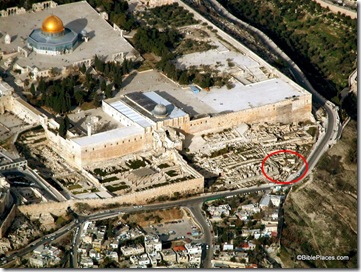A.D. Riddle has pointed me to a chapter that Eilat Mazar published a few years ago entitled “The Solomonic Wall in Jerusalem” (full bibliographic data below).
It includes a diagram similar to the one published on Hebrew U’s Facebook page yesterday. I’ve added labels in English.
 Mazar’s diagram with English labels added (original here)
Mazar’s diagram with English labels added (original here)My impression in reading Mazar’s chapter is that yesterday’s press conference was mostly a re-statement of the conclusions of her 2006 article, which was based on her excavations in the 1980s. In short, she argues that Building C is a four-chambered inner gatehouse which may have been an entrance into a royal palace. She notes that its dimensions are “virtually identical” to those of palace Gate 1567 at Megiddo VA-IVB. With regard to date, she states that “the ceramic data were insufficient to provide a more precise determination within the terminus post quem time frame for the construction of Building C.”
She found two floors in Building D, the later of which was laid “no earlier than the 8th century.” She believes an intact black juglet was placed under a foundation stone as a “construction offering” and dates the building to the 10th century.
She concludes in part:
Based on the finds sealed below the floors of Buildings C and D, the construction of the fortification complex in the Ophel should be dated to the 10th century BCE. This date corresponds to the biblical passage announcing that King Solomon built a defensive wall around Jerusalem. There is no reason to assume that someone other than Solomon constructed or reconstructed the Ophel fortification line at some time during the 10th-9th centuries BCE.
It sounds as if Mazar has found more evidence in her recent excavation that confirms her previous conclusion that this fortification system dates to the time of Solomon. I don’t believe that her previous conclusions met with much enthusiasm from the scholarly community; we’ll see how the archaeologists evaluate her new material.
The bibliographic data for this publication is as follows:
Mazar, Eilat. 2006 “The Solomonic Wall in Jerusalem.” Pp. 775-786 in “I Will Speak the Riddles of Ancient Times”: Archaeological and Historical Studies in Honor of Amihai Mazar on the Occasion of His Sixtieth Birthday. Ed. A. Maeir and P. de Miroschedji. Winona Lake: Eisenbrauns.
This two-volume work is available from Eisenbrauns.

